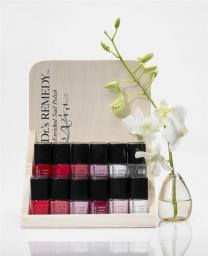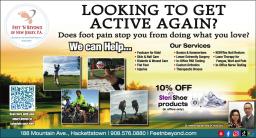
- (908) 576-0880
-
188 Mountain Avenue
Hackettstown, NJ 07840 - fax: (908) 576-0881
- email: info@feetnbeyond.com
Visit Our Website: https://fnbnj.midasmedical.us/free-initialconsultmtolive
Podiatrists in Hackettstown, New Jersey
At Feet ‘N Beyond of New Jersey, P.A., we go above and beyond in our service to those in our community, providing complete and comprehensive foot care for Morris, Sussex and Warren counties, New Jersey. Feet ‘N Beyond of New Jersey is a division of the New Jersey Podiatric Physicians and Surgeons Group (NJPPSG), an organization of 50+ physicians practicing foot and ankle surgery and podiatric medicine in New Jersey. The goal of NJPPSG is “to set the highest standard of care for podiatry patients throughout the state and ensure you have the resources necessary to find a local podiatrist and practice to solve your foot and ankle problems.” We are your local podiatry professionals, ready to serve those interested in the NJPPSG podiatry group’s superior quality of care.
Please fill out Registration forms before your visit on our website. |
We Accept
Saturday appointments will be by appointment only. |
-
- Dr.'s Remedy Nail Polishes
- $14.00
- Note: Special Saving Available, see Coupons
Dr.'s Remedy Enriched Nail Polishes
Natural nail polish….beautifully colored nails without dangerous chemicals! Protects Nails From Fungal Disease Dr.'s Remedy Enriched Nail Polishes appeal to health-conscious women, including pregnant women, because it removes the potentially harmful additives found in most commercial nail polishes. Created, tested, and prescribed by doctors. What’s Not In This Polish (but usually found in other polishes):- Formaldehyde, a chemical which has been proven to cause cancer.
- DBP, a potential developmental and reproductive toxin that may cause birth defects and is banned in Europe.
- Toluene, a chemical that the EPA restricts in our drinking water because it can cause nervous system disorders as well as damage to the liver and kidneys.
- Vitamin C and E (for healthier nails)
- Wheat Protein (contains protein and amino acids)
- Tea Tree Oil ( an essential oil obtained rom the leaves of a plant native to Australia, which has been found to have antiseptic and anti-fungal activity)
- Garlic Bulb Extract (found to have anti-fungal properties).
- Produces beautifully colored nails while helping to keep them healthy.
- Polish lasts as long as polishes containing harmful ingredients.
- No scrubbing at that icky yellow formaldehyde tint left behind by other polishes.
- Contains anti-fungal ingredients that help protect nails from fungal diseases (Fungal diseases produce thick, discolored, deformed, foul smelling nails).
- Doctor tested and prescribed.
- Contains natural ingredients, not harmful ones.
Available Colors:
- Basic: clear base coat
- Relaxing: a light pink rose
- Balance: warm brick red
- Purity: sheer classic pink
- Clarity Coral: an orange-red coral
- Rescue: perfectly rich red
- Calming: clear polish and/or topcoat
- Defense: deep dark red
- Positive: a creamy pastel pink
- Whisper: a white out French tip or solid white polish
- Purple Passion: A plum frost with a hint of shimmer
- Blissful Bronze: A golden bronzy pearl
- Mellow Mauve: A dusty rose
- Focus Fuchsia: A bright purple raspberry
- Peaceful Pink Coral: A bright peachy
- Laser Treatments
May 1, 2010 HACKETTSTOWN, NJ The doctors of Podiatric Medicine and Surgery, Dr. Helene Nguyen and Dr. Yong Zhu of Feet ‘N Beyond of New Jersey, P.A. announce the cutting edge K Laser Therapy Technology, which is proven to “Biostimulate” tissue, enhance repair and promote growth, while decreasing inflammation and pain. It is now available by appointment at two of their New Jersey office locations: 57 Route 46 East, Hackettstown (across from Target) and 1259 Route 46 East, Parsippany. K Laser Treatment is a safe and painless procedure that can be an effective alternative to surgery for many who experience pain or discomfort from conditions like tendonitis, neuroma, nerve pain, or joint pain from degenerative joint disease or Rheumatoid Arthritis. Studies also show that Laser Therapy helps with any type of inflammatory disease or condition. It is used for pain management, to help heal soft tissue Injuries, and for wound healing. The doctors at Feet ‘N Beyond also offer the innovative off-labeled laser technology for fungal toenails treatment as a nail restoration system. Only minutes per session will result in sustained effects. Painless Therapy, Positive Effects Laser therapy is painless and the effects are amazing. The treatment promotes increased circulation, increased metabolic activities, immune system stimulation, nerve regeneration, muscle relaxation, acceleration of cell reproduction and growth. As the laser heals tissue, patients experience relief from foot and ankle pain along with improved range of motion and function. They enjoy increased joint flexibility and a faster recovery from injuries. The Science behind the Therapy Known as “Class IV Laser Therapy,” the K-Laser employs dual infrared wavelengths simultaneously of 800nm (nanometers) and 970nm, which penetrate deep into the tissue for consistent and safe treatment results. The K-Laser’s dual wavelengths coupled with its wide range of watt power, provide the perfect combination to NOT only eliminate fungus, but to reduce pain dramatically with sustained effects as well. Patients report that they experience no side effects of this treatment, and that it is non-addictive, unlike some prescription pain medications. In fact, the laser therapy does not require the use of drugs of any kind. How Does it Work? During each painless treatment, the infrared laser light interacts with tissues at the cellular level, resulting in an increase of metabolic activity within the cell and improving the transport of nutrients across the cell membrane. With the release of nitric oxide, the laser energy increases circulation. It draws water, oxygen and nutrients to the damaged area, reducing inflammation, swelling, muscle spasms, stiffness and pain. A Doctor of Podiatric Medicine (DPM) is the only health professional whose total training focuses on the foot, ankle and related body systems. Professionals Dr. Helene T. Nguyen and Dr. Yong J. Zhu, at Feet ‘N Beyond of New Jersey maintain the highest levels of accreditation and pursue ongoing education to stay abreast of the latest trends in podiatry. They specialize in the diagnosis, treatment and prevention of foot and ankle problems with medical and surgical approaches. Those interested in this laser treatment for beautiful toenails, pain relief, and its healing effects should call for a Complimentary Consultation, during which the doctors and staff will discuss the length of therapy and options for financial arrangements. For an appointment or more information, call their office toll free: 800FNBNJ04 (800.362.6504) or 908.576.0880 or email info@feetnbeyond.comWebpage http://musconetcongnews.coolerads.com/businesses/profile/168718/pages/249
- Posted 2010-05-01
-
- Diabetes and Your Feet
According to the American Diabetes Association, about 15.7 million people (5.9 percent of the United States population) have diabetes. Nervous system damage (also called neuropathy) affects about 60 to 70 percent of people with diabetes and is a major complication that may cause diabetics to lose feeling in their feet or hands. Foot problems are a big risk in diabetics. Diabetics must constantly monitor their feet or face severe consequences, including amputation. With a diabetic foot, a wound as small as a blister from wearing a shoe that's too tight can cause a lot of damage. Diabetes decreases blood flow, so injuries are slow to heal. When your wound is not healing, it's at risk for infection. As a diabetic, your infections spread quickly. If you have diabetes, you should inspect your feet every day. Look for puncture wounds, bruises, pressure areas, redness, warmth, blisters, ulcers, scratches, cuts and nail problems. Get someone to help you, or use a mirror. Here's some basic advice for taking care of your feet:
- Always keep your feet warm.
- Don't get your feet wet in snow or rain.
- Don't put your feet on radiators or in front of the fireplace.
- Don't smoke or sit cross-legged. Both decrease blood supply to your feet.
- Don't soak your feet.
- Don't use antiseptic solutions, drugstore medications, heating pads or sharp instruments on your feet.
- Trim your toenails straight across. Avoid cutting the corners. Use a nail file or emery board. If you find an ingrown toenail, contact our office.
- Use quality lotion to keep the skin of your feet soft and moist, but don't put any lotion between your toes.
- Wash your feet every day with mild soap and warm water.
- Wear loose socks to bed.
- Wear warm socks and shoes in winter.
- When drying your feet, pat each foot with a towel and be careful between your toes.
- Buy shoes that are comfortable without a "breaking in" period. Check how your shoe fits in width, length, back, bottom of heel, and sole. Avoid pointed-toe styles and high heels. Try to get shoes made with leather upper material and deep toe boxes. Wear new shoes for only two hours or less at a time. Don't wear the same pair everyday. Inspect the inside of each shoe before putting it on. Don't lace your shoes too tightly or loosely.
- Choose socks and stockings carefully. Wear clean, dry socks every day. Avoid socks with holes or wrinkles. Thin cotton socks are more absorbent for summer wear. Square-toes socks will not squeeze your toes. Avoid stockings with elastic tops.
When your feet become numb, they are at risk for becoming deformed. One way this happens is through ulcers. Open sores may become infected. Another way is the bone condition Charcot (pronounced "sharko") foot. This is one of the most serious foot problems you can face. It warps the shape of your foot when your bones fracture and disintegrate, and yet you continue to walk on it because it doesn't hurt. Diabetic foot ulcers and early phases of Charcot fractures can be treated with a total contact cast. The shape of your foot molds the cast. It lets your ulcer heal by distributing weight and relieving pressure. If you have Charcot foot, the cast controls your foot's movement and supports its contours if you don't put any weight on it. To use a total contact cast, you need good blood flow in your foot. The cast is changed every week or two until your foot heals. A custom-walking boot is another way to treat your Charcot foot. It supports the foot until all the swelling goes down, which can take as long as a year. You should keep from putting your weight on the Charcot foot. Surgery is considered if your deformity is too severe for a brace or shoe. Coming soon.
- Posted 2009-12-02
- Orthotics
-
Orthotics, also known as orthoses, refers to any device inserted into a shoe, ranging from felt pads to custom-made shoe inserts that correct an abnormal or irregular, walking pattern. Sometimes called arch supports, orthotics allow people to stand, walk, and run more efficiently and comfortably. While over-the-counter orthotic are available and may help people with mild symptoms, they normally cannot correct the wide range of symptoms that prescription foot orthoses can since they are not custom made to fit an individual's unique foot structure. Orthotic devices come in many shapes, sizes, and materials and fall into three main categories: those designed to change foot function, those that are primarily protective in nature, and those that combine functional control and protection. Rigid Orthotics Rigid orthotic devices are designed to control function and are used primarily for walking or dress shoes. They are often composed of a firm material, such as plastic or carbon fiber. Rigid orthotics are made from a mold after a podiatrist takes a plaster cast or other kind of image of the foot. Rigid orthotics control motion in the two major foot joints that lie directly below the ankle joint and may improve or eliminate strains, aches, and pains in the legs, thighs, and lower back.
Soft Orthotics Soft orthotics are generally used to absorb shock, increase balance, and take pressure off uncomfortable or sore spots. They are usually effective for diabetic, arthritic, and deformed feet. Soft orthotics are typically made up of soft, cushioned materials so that they can be worn against the sole of the foot, extending from the heel past the ball of the foot, including the toes. Like rigid orthotics, soft orthotics are also made from a mold after a podiatrist takes a plaster cast or other kind of image of the foot. Semi-Rigid Orthotics Semi-rigid orthotics provide foot balance for walking or participating in sports. The typical semi-rigid orthotic is made up of layers of soft material, reinforced with more rigid materials. Semi-rigid orthotics are often prescribed for children to treat flatfoot and in-toeing or out-toeing disorders. These orthotics are also used to help athletes mitigate pain while they train and compete.
- Posted 2009-12-02
As Seen in My Life Publications/ Maljon LLC on 08/16/2021 |
| Click on ad to enlarge |


